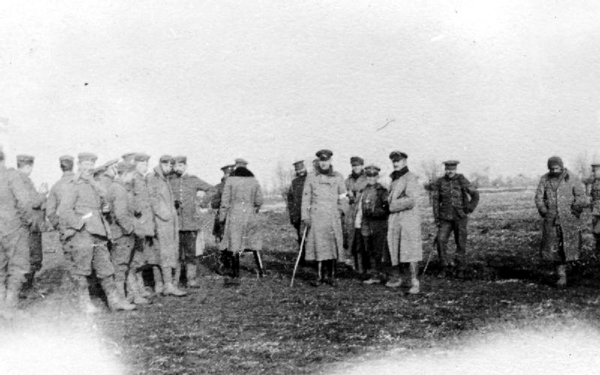Christmas 1914 and World War One
There are many myths surrounding Christmas during World War One, particularly the first Christmas in December 1914.
As the first year of the war drew to a close, the British public and the soldiers on the front line were still being fed information that portrayed the Germans as psychopaths and blood-thirsty killers. This image was one the government and military commanders wanted to uphold - while they were considered inhuman, it was possible to justify almost any strategy.
However, this impression was broken during the Christmas of 1914. Initially, there were only whispers of fraternisation, which the Allied commanders were quick to attempt to clamp down on. But researcher Stanley Weintraub has managed to prove that fraternisation was very much taking place - improvised but with ‘rules’ quickly built in.
According to Weintraub, the first signs took place in the trenches when the Berkshire Regiment faced the XIX Corps of the German Army. The XIX’s, from Saxony, started to put up small conifers as it approached Christmas so as to replicate the appearance of Christmas trees. The Berkshires could see the trees, which lined the tops of the trenches.

Initially, small groups of Berkshires and Saxons met in No-Mans Land, ignoring the fact that they were breaking military law, and discussed the possibility of a truce. The Britons were understandably suspicious - concerned that the offer of goodwill was merely an attempt to lure out the troops. However, the cease fire took place for 24 hours from Christmas Eve to Christmas Day, and soon the soldiers from both sides were in the festive spirit.
The spirits were lifted further by the fact that both sides had received Christmas gifts; the British received a card from King George V and a gift from his daughter, Princess Mary. Soon, Christmas carols were being sung between trenches all up the Western Front, prompting more and more soldiers to emerge from their lines and greet the enemy. No one is certain who initiated the impromptu meetings, but there is evidence to suggest Germany’s carol singing marked the start.
On Christmas Day itself, unarmed German and British soldiers started by collecting their dead from No-Man’s Land, which was a pre-condition for the cease-fire. Many soldiers were buried alongside each other in burial services, such as one held in Lille.
Once this was achieved, the soldiers began to celebrate by giving gifts of food, including Sauerkraut, sausages and chocolate. Some sectors even joined together to go on a communal hunt for hares, which resulted in meat for dinner.
Of course, there were also the famed football matches that took place in a number of areas along the front lines. The records from the 133rd Saxon Regiment recorded a football match that was won by them 3-2.
Once midnight approached, the men from both sides began to return to their trenches, and pre-arranged signals called in the stragglers. Finally, flares were launched as a symbol that the cease-fire was over. The following day, the shooting began once more.
Despite not condoning the cease-fire, Field Marshall Sir John French's HQ issued a statement that the lack of firing on the Western Front was "a comparative lull on account of the stormy weather."
Other statements also emerged from the troops, who had seemingly revelled in their 24 hours of fraternisation with the enemy.
"Altogether we had a great day with our enemies, and parted with much hand-shaking and mutual goodwill." Percy Jones of the Queen's Westminster Regiment.
"It was a curious scene - a lovely moonlit (Christmas) night, the German trenches with small lights on them, and the men on both sides gathered in groups on the parapets. It is weird to think that tomorrow night we shall be at it again. If one gets through this show it will be a Christmas time to live in one's memory." Captain R Armes of the 1st North Staffordshire regiment.
"It was absolutely astounding, and if I had seen it on a cinematograph film I should have sworn that it was faked." Lieutenant Sir Edward Hulse, 2nd Scots Guards.
"What a sight; little groups of Germans and British extending along the length of our front. Out of the darkness we could hear the laughter and see lighted matches. Where they couldn't talk the language, they made themselves understood by signs, and everyone seemed to be getting on nicely. Here we were laughing and chatting to men whom only a few hours before we were trying to kill " Corporal John Ferguson of the Seaforth Highlanders.
MLA Citation/Reference
"Christmas 1914 and World War One". HistoryLearning.com. 2024. Web.
